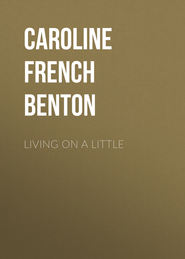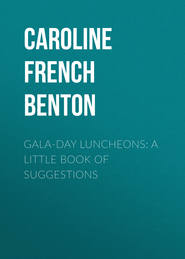По всем вопросам обращайтесь на: info@litportal.ru
(©) 2003-2024.
✖
The Complete Club Book for Women
Настройки чтения
Размер шрифта
Высота строк
Поля
"Child Labor in City Streets," E. N. Clopper. (Macmillan.) "The Cry of the Children," Mrs. B. Van Vorst. (Moffat, Yard.) "Solution of the Child Labor Problem," S. Nearing. (Moffat, Yard.) "The Children in the Shadow," E. K. Coulter. (McBride, Nast & Co.) "Through the Mill," F. K. Brown. (Pilgrim Press, Boston.) "Juvenile Offenders," W. D. Morrison. (Appleton.)
PART IV
AMERICAN NATURE WRITERS
Toward spring clubs which have taken a heavy subject all winter will enjoy a program of ten meetings on our own writers about nature. The life of each should first be fully studied, and there may be many readings from books.
The story of John James Audubon is as interesting as the most romantic novel. Study this in full and describe his great book, "Birds of America"; read from his granddaughter's (Maria B. Audubon) "Life of Audubon" (Scribner).
Henry David Thoreau is a unique figure in our literary history. Read some of his poems; also Stevenson's sketch in "Familiar Studies;" and from "Thoreau," by F. B. Sanborn (Houghton Mifflin Co.).
John Burroughs is the most popular of our nature writers. Read "Wake Robin," "Birds and Poets," and "Indoor Studies" (Houghton Mifflin Co.).
John Muir though not an American by birth, was our chief scientific writer about nature. Read from "The Mountains of California" (Century Co.); "Our National Parks" (Houghton Mifflin Co.).
Stewart Edward White writes of the mountains and forests. Read: "The Forest" (Doubleday, Page), and "The Pass" (Outing Co.).
Select chapters from Ernest Thompson Seton's "The Biography of a Grizzly" (Century Co.), "Lives of the Hunted" (Scribner).
Read from Theodore Roosevelt's "The Hunting Trips of a Ranchman," "Hunting the Grizzly" (Putnam), and "Good Hunting" (Harper).
Read briefly of Henry C. McCook's life, and then from "Nature's Craftsmen" (Harper), and "Tenants of an Old Farm" (Jacobs).
Read selections from the books of Mabel Osgood Wright and Olive Thorne Miller.
Have readings from "The Nature Lovers' Treasury," by Carrie T. Lowell (The Page Company).
CHAPTER X
Central and South America and the Canal
There is a certain romantic interest about the history of Central and South America and a uniting of ancient and modern history there which makes its study peculiarly attractive. Sufficient material is given for an entire year's work, and the many books written recently upon them give ample references.
I – THE BEGINNINGS
Starting with Central America, the first meeting may be upon its physical features, illustrated with a map. It is believed that originally there may have been a great archipelago uniting the two continents, earthquakes possibly throwing them together. The Cordillera, or mountain chain, which lies the length of the peninsula, is of unusual wildness and beauty, with volcanoes here and there. The long slopes from the sea to the mountain tops give great variety of climate and productions, remarkable in so small a country. Describe at length the flora and fauna.
This will introduce the great subject of the ancient remains of a highly civilized race. There are huge pyramids, vying with those of Egypt, walls built without plaster yet of amazing durability, temples with carvings and colored picture-writing of wonderful beauty, all the subject of great interest to archæologists. Show photographs of these, and discuss whether they were connected with the remains in Egypt or were a spontaneous development of an aboriginal race.
After this take up the coming of the European and the result. In 1513 Balboa saw the great Pacific Ocean spread out before him. Wading into its water he took all the land upon its shore in the name of Spain – which was the entire territory from Alaska to Cape Horn. Read: – Keats's sonnet "On first looking into Chopman's Homer," with its reference to the "peak in Darien."
Spain proceeded to take possession of the country to the immediate north and south, and kept it until 1821; it stamped its peoples indelibly with its mark and made it more Spanish than Western in customs, religion and morals. Notice the curious fact that a canal across Panama was suggested by Spain in 1551. Follow the history of these centuries until Spain lost its ownership; then speak of the federal republic, and later of the founding of the different republics as they are to-day. This will take several meetings.
II – THE CENTRAL AMERICAN REPUBLICS
From this point study each little republic by itself, beginning with Guatemala, the farthest north, adjoining Mexico, and resembling it in many ways.
Here the feature of prime importance is the natural forests of rare woods; the soil is also unusually fertile and can be made to produce remarkable crops under cultivation. The cities are modern; Guatemala City has tree-planted avenues, a beautiful plaza, electric lights, schools and churches. Manufactures and trades are interesting, especially the wood-carving and embroidery work. Give an idea of the people, native and foreign, the government, education, and relation with other countries.
Nicaragua, territorially the largest of the little republics, is interesting because of its connection with the early plans for the great canal. It was chosen in 1876 in Washington, President Grant determining upon it after many years of investigation. Read in "Panama," by Bunau-Varilla, of this period. Mention also the three interesting towns connected by railway, and the great plantations near them.
Honduras is a remarkable place in many ways; describe its capital, with its law courts, its university and schools of industry; also the wonderful mines, so few of them developed.
British Honduras is by no means so interesting; but its form of government should be noticed. One curious little fact is that it is recorded that one year all the pine trees on crown lands were sold to an American for a cent apiece.
Salvador is a wild, mountainous, picturesque place, situated in a district which volcanoes constantly threaten. Its main city, San Salvador, has many buildings of note.
Costa Rica has a history of absorbing interest. Its great wealth of minerals, trees, pearl fisheries and other resources early made it famous in Spain. Its climate is delightful, its population mostly foreign, education is free, and there is complete religious liberty. Discuss what causes the difference between this republic and some of the others.
III – PANAMA AND THE CANAL
Panama, the little republic of only ten years, is sufficiently important commercially to be noticed, yet its fame will always rest upon its great canal. Clubs should give a number of meetings upon this subject, for it is of world-wide interest, and the future of South America, and largely our own, is closely connected with it.
The early dream of such a canal should first be followed out from its inception till the time of the formation of the early company by De Lesseps in 1881, through the failure of this with its disastrous financial effect in France. New plans were made which were to enlist the help of Russia, but these failed also. Study the idea of the Nicaraguan canal, its abandonment; the negotiations with Colombia; the treaties made; the difficulties with the different South American countries; the recognition of Panama by the four great powers; the ratification by the Senate of the Hay-Bunau-Varilla treaty, the making of plans for the canal on different lines, and, last, its actual beginning.
Here there should be a paper on the physical conditions at Panama, the deadly climate, the yellow fever, the malarial mosquitoes, the lack of sanitation, and all that was carried out under Goethals and Gorgas to make it possible for the work to be done. Read descriptions of the town of Panama after the new conditions were established. Show a map of the Canal and describe its principal features and also show pictures from magazines and books. Close these meetings with a discussion on two questions: the tolls, and the possible fortifying of the Canal. Give some idea also of the result of the building of the Canal upon the different nations.
IV – SOUTH AMERICA
The study of South America should be taken in a leisurely way, for each part is valuable. Begin with a map talk, pointing out the divisions, the mountains, rivers and cities, and the great fertile plains.
The ancient history of the land will come first. Read from Prescott the description of the Incas in Peru and their remarkable civilization, and show pictures of the remains of temples and walls. Contrast these with the ruins in Central America and point out the striking differences.
Then give several meetings to the coming of the Spaniards and the results, not only to the Incas but to the entire country. Read of the Buccaneers and other adventurers, and have read some chapters from Charles Kingsley's "Westward Ho!"
After this, take each of the countries in turn and thoroughly study its history down to to-day. There are certain divisions which it will be well to follow: first, the Republics of the River Plate, Argentina, Uruguay and Paraguay; the Republics of the Andes, Peru, Ecuador, Bolivia and Chili; the Republics of Colombia and Venezuela; the United States of Brazil; and last, the Guianas.
The River Plate is of remarkable interest; it makes the great prairies or pampas fertile and so is the basis of the wealth of the country.
Argentina, and, in a lesser degree, Uruguay and Paraguay, are dependent upon it.
V – ARGENTINA
Argentina is one of the wonders of the new world, so rapid has been its rise from obscurity to immense material importance. It is considered the first of the South American states. Study the singular mingling of the races which has produced an entirely new type of nationality and patriotism.
The subject of ranches and the life there may be the topic of one paper; another may take up the life in the capital, Buenos Ayres, with its contrasts between great poverty and greater wealth, for the ports are filled with steamers from all parts of the world, and the docks crowded with the very poorest Italian immigrants. The wide boulevards, theaters, opera house, clubs, newspaper offices, and public buildings are on a scale of unusual magnificence. Notice that in many respects the city is like Paris.
Speak of the pleasure-loving character of the people, of horse-races and lotteries, of extravagance in all kinds of sport. Notice the excellent sanitation and the unusually high cost of living. Follow with a description of the other two river republics, and compare with Argentina. Have a paper here on Patagonia.
VI – PERU
The republics of the Andes are less important commercially than those of the lower lands, but in many respects they are of greater interest. The mountains give to them their distinctive character and importance; they are the great storehouse of the people, giving them mineral wealth, forests, and, on the slopes, fertile tracts of land, except on the coastward side, where the peculiarity of the lack of rain makes the country sterile. In Peru the whites and Indians and half-breeds form three distinct classes, and this is true of all the republics of the Andes.
Give a description of Lima, the quaint city which dates from the time of Pizarro, show pictures of the old cathedral and the plaza of infamous memories of persecutions, existing from 1573 until 1813. Contrast this simple, and by no means wealthy, city with those of the Plate country.
Close with a sketch of Cuzco, the capital of the old Inca empire, built almost twelve thousand feet high on a mountain top, and speak of the railroad which goes there, and of the wonderful mountain bridges.
VII – ECUADOR









